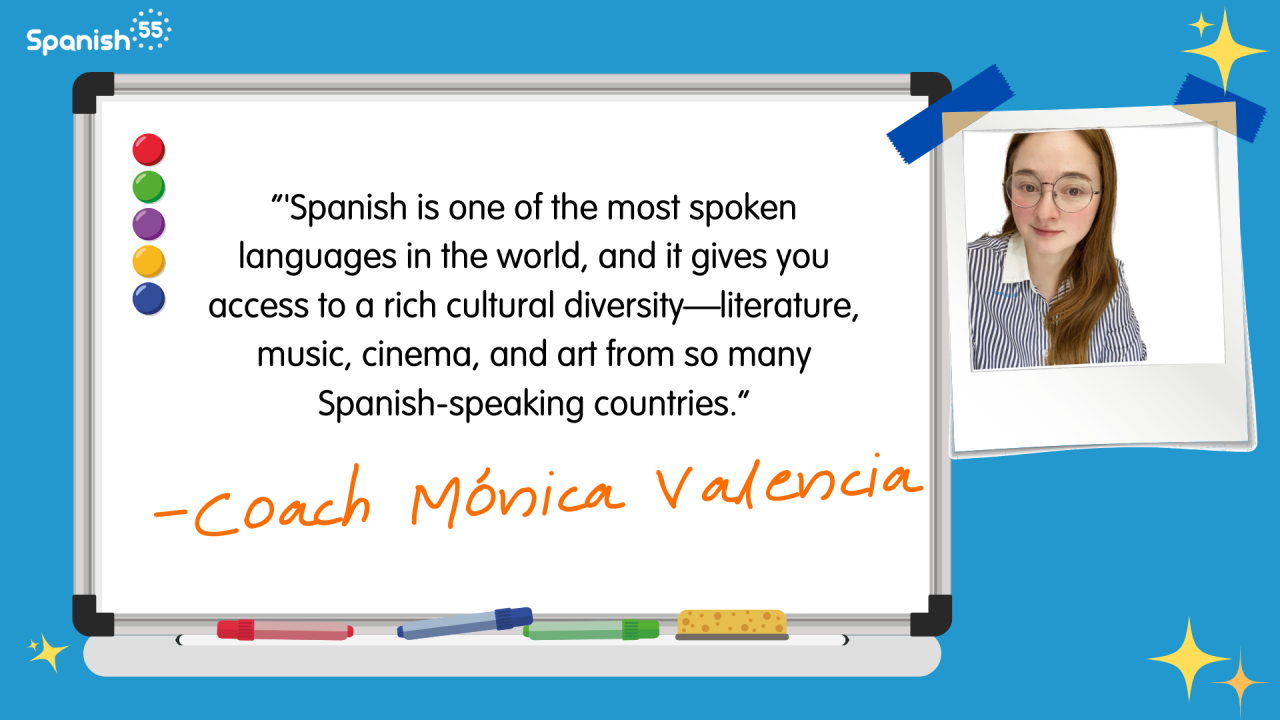The whole process of learning a new language is always an adventure. It has its ups and downs, it requires a lot of work, time and effort; but the destination is even more breathtaking than you imagined. When starting this journey, one of the first questions that will probably come to mind will be: how long is this going to take? You may have an actual event that you need to attend, or you're planning a trip. In these cases, a timeframe is already set for you. If you just feel like learning something new, having an extra skill on your résumé or maybe just an activity to do in the afternoon, then you have all the time in the world. There's absolutely no rush when taking on this expedition. Take your time, look around, absorb as much as you can, and see this learning process just like that: an all-around experience. The US Foreign Service Language Institute divides languages into groups, based on difficulty. Spanish was placed in Group 1, among French, Portuguese, Italian, and others; and was given 480 classroom hours before it can be considered "learned". Now, we very well know that a great amount of the time that we dedicate to study a language is not necessary during "classroom hours". Honestly, there are no strict parameters that will set the exact number of hours, minutes, and seconds we need to assign out of our day to become fluent in Spanish. Most people will say that it really is "up to you". And, even if it's true that "you get out only what you put in", there are 10 factors that can either accelerate or slow down the process.
Physiognomy
The wonders of biological anthropology is a subject that we have approached before, but from a different point of view. As humans, we have different processes of adaptation intrinsic to our surroundings. The physical needs of each of us vary depending on the area where we reside. This affects the development of physical aspects as basic as bone structure; more importantly, the complexion of the skull. The difference between our facial shapes and forms, compared to those of native Spanish speakers, can be an important factor that can influence our learning process. The construction of our mouth itself could slow us down with situations completely out of our control, like rolling Rs, for example. By no means are these bad news. It only means that we need to focus a little more of our energy in certain aspects.
Want to speak Spanish confidently and fluently?
CLAIM YOU FREE SKYPE LESSON NOW
Similarity to First Language
As we mentioned before, the US Foreign Service Language placed Spanish in a group with other ones of similar structure. This first group includes French, German, Indonesian, Italian, Portuguese, Romanian, Spanish and Swahili. Most of these are part of the romance languages, which descend from what was called Vulgar Latin. The story of how these were born is a rather marvelous one. As the Roman Empire acquired more and more territory, its soldiers had to try and understand the local languages the best they could. What they learned from the people they came in contact with was nothing but slang. The villagers even had their fun providing mispronounced words or wrongly translated phrases. These local stocks of words the Romans kept picking up became to them the different languages for each region. Yet, they noticed how all of these had similarities. All those languages had the same roots. That's why we can sometimes recognize grammar rules and structures; or listen to a song in one of these languages and feel like we can pretty much understand the words. Can you remember the "Ai Se Eu Te Pego" phenomenon? It had the entire world phonetically singing lyrics that we couldn't really understand, but they kind of sounded like a few words that we knew, so we used those instead.
If we have knowledge of one of the languages we mentioned before, Spanish will easily come to us, and vice versa.
Age
Who hasn't heard "the younger they start, the better"? And we are not only talking about studying a language, pretty much for every new skill that we want to acquire, the "rule" seems to be the same. However, this is not necessarily a norm. There's research stating that the language acquisition skills peak at the age of six. Harvard studies actually say that the preschool years are the best for a kid to learn a second language, since the foundations for different aptitudes are just getting molded. In this case, the child will not particularly be learning a second language but rather learning two languages in one go. They develop the speaking aspect a lot faster, acquiring a native-like accent almost right away. Being in contact with the language when the brain is still configuring allows children to wire those "strings" connecting it to the mouth in a more flexible way, providing them with the ability to "switch" from one language to another while being pretty much unaware they're doing so.
After the teen years, the brain changes its focus and those skills are "done" developing. That's the reason why it can be harder for adults to learn a second language. Our mind is filled with all the structure necessary for our native tongue. The "switch" becomes a little rusty and flipping it represents a bit of a struggle. The good news is that our brain is constantly looking for new ways to expand its cognitive limitations, especially during adulthood. Taking advantage of this thirst for knowledge can result in a rather joyful experience with a few fun challenges but no difficulties whatsoever.
Motivation
What is the actual reason why you want to learn a second language? This is a question we brought up right from the start. The answer will be our impulse to learn, our motivation. Many studies have been done trying to understand this particular propeller. When we learn our first language, we have an urgency, we need to communicate. Acquiring a second one is not laced with that innate instinct to interact with our immediate surroundings. John Schumann explains that there are two primary motivations to do so: the integrative and the instrumental. Simply put, the integrative touches all the social strings of our brain. It's right there in the name: it's our need to be part of a group, to interact with others, to know and connect with other speakers of this tongue. The instrumental, on the other hand, is practical and has a more concrete purpose. This type of motivation thinks of Spanish as a tool that we must add to our toolbox, maybe for a job, a school grade, a new academic achievement. Which one is yours? Do you have an intellectual urge or a social need? Or better yet, why not combine both? "I wouldn't argue for the supremacy of one over the other in second language acquisition. In most cases of language learning motivation, we have a mixture of integrative and instrumental influences", says Schumann.
Environment
The context where we live in is such a major influence for the Spanish learner. It has everything to do with how in touch we are with the language. Are there any native speakers that live on your block? Maybe at work or a friend of a friend. Believe it or not, every time we hear them talking, or see their writing, our brain captures it and stores it a figurative box with a "foreign language" label. The more in contact we are with these words, our box is going to fill up faster. Once we start taking an actual course, we can sort everything inside that container into verbs, prepositions, adjectives, and the like. The more content we have to work with, the easier this whole process will be. If by any chance you don't usually find yourself in contact with the language, you can create this environment yourself! Play music in Spanish, change the language settings on your Netflix profile, try to mix the Spanish words you already know into your everyday conversations. It's easier than you think!
Learning Techniques
The topic we just touched upon is called "language immersion" and it's one of the best learning techniques there is. We are not learning a second language, we are becoming bilingual. We are talking about developing the ability to "flip" that switch with ease. The reason why this is so effective is because we are somewhat training our brains to make the necessary connections between the two languages a lot faster. Within this technique we can find different stages: There is total immersion, which means that the entire class is instructed using the target language exclusively. From the instructions to the exercises to the assessments, even behavior corrections are provided in the second language. This requires great amounts of interpretation from the student, and can leave the students with concepts that they don't understand. When the partial immersion technique involves both languages, it's more permissive when it comes to the teacher going back and forth. It is also important to identify which are our sensory preferences. What does this mean? Knowing if we learn by listening, maybe we are more visual and can remember things better if they are shown in images or graphically explained. Other perceptual learning channels can be through touching or by physically doing stuff, which are called tactile and kinesthetic, respectively. We can't leave out the teacher! They're, of course, one of the key elements in this process. It's important to find a teacher with the right knowledge, that can handle different techniques, but it's also relevant to have someone we can connect with. The social relationship is just meaningful as the academic.
Economy
What wouldn't we give to travel the world, visit marvelous cities, eat exotic food, and learn romantic languages? Unfortunately, not everybody has the monetary possibility to do so. Well, we have more good news: there are many other ways to learn that are even as or more effective and cost much, much less. There are many apps we can use for free, and you've probably already tried them all, but there's nothing like personalized classes. Those can be expensive too, we know, maybe there aren't any near us, or don't fit our schedule. Well, here's some more good news! Spanish55 has kept all of that in mind, that's why we offer 55 minute classes that you can take online at affordable prices. On top of that, the more you use us, the more you save.
Time
How much time we dedicate to learning Spanish is another important aspect to take into consideration. As we mentioned before, we know very well that not all the time we spend in contact with the language is during class hours. The key here is to be as exposed to Spanish inside the classroom as we are outside. This is easier than you think. Theoretically, we could spend as much as ten hours per day learning Spanish. Just picture this: as we get ready in the morning we put a Spanish-language show on the TV in the background, we listen to Spanish music in the car and as we work, read in this language as we have lunch, listen to podcasts while walking the dog, watch a movie or TV series as we unwind for the day. The cherry on top can be those 55 minutes with your personal Spanish55 instructor.
The skill you're aiming for
The acquisition of any language involves four essential skills: listening, speaking, reading, and writing, each one linked to the other in that specific order. Listening and reading are passive skills, that's why they're usually developed first. It's a lot easier to consume the language than producing it. Yet, we need to be aware of this process. We must be active consumers, consciously absorbing the words either coming from the speakers or the ones printed on the pages. Speaking and writing are considered "more difficult" but, in reality, they just seem like it because they are productive skills. These demand more effort from us than the other two. While the first ones simply ask us to assimilate the information, this other couple makes us take it to next level and actually reproduce it. All of this only means that, if our goal is to learn how to write in Spanish, it's going to take longer than if all we need is to understand it.
Level
Once we determine which or how many skills we want to work on, it's time to decide what's the level we want to reach. The US Foreign Service Language Institute has established five levels of proficiency: Elementary proficiency: the person is able to satisfy routine travel needs and minimum courtesy requirements. Limited working proficiency: the person is able to satisfy routine social demands and limited work requirements. Minimum professional proficiency: the person can speak the language with sufficient structural accuracy and vocabulary to participate effectively in most formal and informal conversations on practical, social, and professional topics. Full professional proficiency: the person uses the language fluently and accurately on all levels normally pertinent to professional needs. Native or bilingual proficiency: the person has speaking proficiency equivalent to that of an educated n












